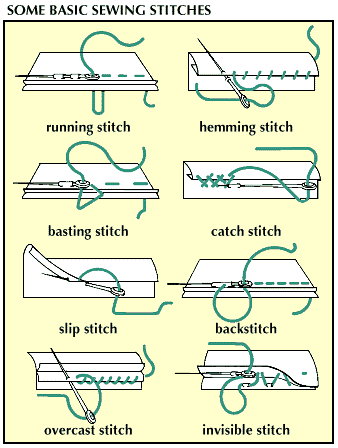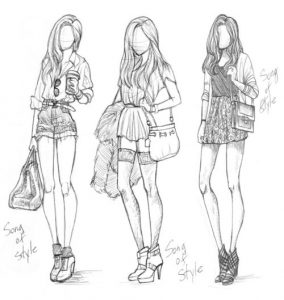6 Tips for Learning to Sew Without Patterns
Imagine if you could see something cute in the store, go home and make it yourself without having to find or follow a confusing pattern. If that sounds too good to be true, then you’re in the right place. Today I’m going to give you some of my tips on how I sew without patterns. Keep in mind that these aren’t instructions because there aren’t any patterns! I free hand a lot of my projects, so there’s good bit of faith and maybe some luck involved in this process. Just remember to be open to making mistakes and learn from them.
Tip #1: Get Some Basics Under Your Belt
 Seriously, sewing without a pattern is so much easier if you know how to sew in the first place (duh). Learn some basic stitches and seams and practice them on scrap fabric. Sew pieces of material together, and even try sewing 2 different materials together. Look for basics on making sleeves, hems, collars, etc and practice, practice, PRACTICE! Also, find yourself a sewing machine with a variety of stitch patterns. This will help you work faster and make your items look more clean and professionally made.
Seriously, sewing without a pattern is so much easier if you know how to sew in the first place (duh). Learn some basic stitches and seams and practice them on scrap fabric. Sew pieces of material together, and even try sewing 2 different materials together. Look for basics on making sleeves, hems, collars, etc and practice, practice, PRACTICE! Also, find yourself a sewing machine with a variety of stitch patterns. This will help you work faster and make your items look more clean and professionally made.
Here are some resources for basic sewing instructions:
AllFreeSewing.com Sewing Basics
Stitch and Sew Beginner Sewing Guide
Tip #2: Do Some Sketches
 I find it a lot easier to figure out how something goes together if I sketch it out on paper. Think of this process as brainstorming your thoughts like you would when preparing to write an essay. Try and sketch out what all of the pieces look like separate from each other (see tip #4 for more about this).
I find it a lot easier to figure out how something goes together if I sketch it out on paper. Think of this process as brainstorming your thoughts like you would when preparing to write an essay. Try and sketch out what all of the pieces look like separate from each other (see tip #4 for more about this).
It can also be useful to sketch all kinds of clothing for fun. As an illustrator, I find that if I “construct” an outfit or piece of clothing on paper, I get a better idea of how it flows, falls and functions. So have some fun and do some fashion design sketches in your spare time. You don’t have to be an artist to do this either. Your drawings just have to make sense to you so you can look back on them later if you need. If you need some drawing help, you can always look for fashion croquis. They’re basically blank body forms that you can trace and build off of. This is a good resource for both male and female croquis, but you can also get good results by Google Image searching for them.
Tip #3: Look Closely
Another very important part of sewing without a pattern is to inspect an already made item that’s similar to what you want to make. Want to make a dress? Go find a dress and turn it inside out! Check out every inch of the seams and see where and how they attach to the other parts of the garment. Test some of these methods on scrap fabric if you want so you can get a feel for how it will work.
Tip #4: Imagine it Flat
 Think back and remember your geometry class kids, because you’re going to need it to be able to do this successfully. When you have a cube broken down into a flat shape, it looks like the image on the left. In case you haven’t figured it out yet, that’s how patterns are made! You need to see all of the parts of the garment broken down into flat shapes. This can easily be done by flipping the item inside out and putting a piece of cardboard inside of it behind the piece you’re looking at. You will be able to see the flat shape of that part and you can trace it if you want.
Think back and remember your geometry class kids, because you’re going to need it to be able to do this successfully. When you have a cube broken down into a flat shape, it looks like the image on the left. In case you haven’t figured it out yet, that’s how patterns are made! You need to see all of the parts of the garment broken down into flat shapes. This can easily be done by flipping the item inside out and putting a piece of cardboard inside of it behind the piece you’re looking at. You will be able to see the flat shape of that part and you can trace it if you want.
*Always keep seam allowance in mind! I typically leave 1/2 – 3/4 of an inch to be absolutely safe. When you’re doing this without a pattern you have almost no room for error, so leave yourself a safety net.
Tip #5: Look for Inspiration
You know that the more you see something the more familiar with it you become. So why not become more familiar with everything you want to make? Go to Pinterest, Tumblr or where ever and take some time to look at other items like the one you’re going to make. On Pinterest, I tend to make a board for each project I’m working on and keep an ongoing of samples, even after I begin the project. Having constant inspiration can help you to refine exactly what you want to make and give you ideas to make lots of stuff in the future!
Tip #6: Practice and Do a Test Run
Self explanatory, isn’t it? Well, yes, but it needs to be stated and stressed over and over. Just like you need to practice over and over. One of the best things to do, if you can afford it, is to build up a collection of cheap, basic fabric. I like to use old tshirts and other old clothing, but you could also get inexpensive quilting cotton or muslin. Before you embark on a project you’re not sure of, make a quick dummy out of the cheap fabric. You don’t have to have beautiful seams or cuts, so it can be done fairly quick and you can learn a lot just from doing the test run.
—
Do you have any tips or stories about sewing without a pattern? Let’s talk about it in the comments! Feel free to share images, links and more. Also, if you think I should add a tip to this list, send me a message. Thanks for reading and don’t forget to share!

One of my biggest regrets is not learning how to sew without a pattern from my Grandma before her sight deteriorated. She passed in 2009 and I thought I lost my chance forever. Thanks for this post. I have hope that I can teach myself and, perhaps, become as skilled as she was.
This makes me smile to hear that this post helped you out! My condolences about your grandma <3 My grandma was big on crochet and when I was a child I never took interest in it. Now that I'm older and I appreciate the art, I always wish I could share it with her. I like to think of it as a way to remember her that she would be proud of 🙂
If you're wanting to learn to sew without patterns, I'm actually working on a series of "Sewing 101" posts for this summer that will go over a few projects that require drafting your own custom fit pattern. You can check out the first post here: https://madebyhand.market/blog/post/sewing-101-lets-talk-about-fabric/ Right now in June I'm trying to lay out some useful references on fundamental skills, then starting in July I will be diving into the actual projects.
I hope you'll join me and try your hand at some "freehand" sewing. I'm sure you'll be able to pick it up no problem!
I sure will! Thank you, Rachel. I feel more hopeful about learning that skill now than I did before.